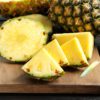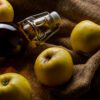Fruited beer wasn’t invented in America, but American brewers put their own stamp on the craft of brewing with fruit purees. This American Craft Beer Week, we’re celebrating those fruit beer pioneers.
When did brewers start adding fruits to their beer?
People have been brewing beer with fruits for thousands of years. In ancient Egypt, brewers were adding dates and pomegranates to flavor their beer by at least 2,500 BC. As early as 775 AD, Norsemen were fermenting mead with honey and fruits because, despite their rough exterior, Vikings had a sweet tooth. And, of course, throughout European culinary history, certain regions have become identified with their forays into fruit beers, including the Lambic beers of Belgium and the salty Gose of Germany.
When did American brewers begin experimenting with fruit beers?
Prior to the Industrial Revolution, it would be fair to say that all American brewers were craft brewers, and most appeared to at least occasionally experiment with fruited beers. In 1771, a treatise titled Transactions of the American Philosophical Society describes “an excellent beer made of persimmons in some of the southern provinces” while a late 19th century historian recorded a recipe for a pumpkin beer brewed in taverns during the Colonial era. However, basic wheat beers a la Yuengling and Coors were the standard for brewers throughout much of U.S. history.
Craft beer took a radical turn in the 1980s.
Home brewing was legalized in the 1978, which opened the field to more players, and they weren’t afraid to try a few wild and crazy ideas. The 80s also brought an explosion of new exotic fruits to market, like the Asian pear, star fruit, passion fruit, and prickly pear. This fortunate fusion of events led to many microbreweries giving old favorites like wheat ales a tropical fruit makeover. Even porters and stouts were lightened up with bursts of cherry and plum.
What’s the state of the fruited craft beer today?
In 1996, New Glarus Brewing Company became the first U.S. craft brewery to win an international beer competition with its Wisconsin Belgian Red, which jams the flavor of juicy cherries into every bottle. The following year, dozens of new categories were added to the Great American Beer Festival competition, including fruit beers. New Glarus took the first and third in that competition for its cherry-flavored Belgian Red and its Apple Ale, respectively. Today, microbreweries and large commercial breweries alike are taking advantage of asceptic fruit purees to refine modern beers like the hazy IPA and to put a new spin on old classics like farmhouse ales, and consumers are drinking it up as fast as they can ferment it.
Ready to experiment with flavor?
While Purée Arête has a distinctive European Influence, we’ve been providing American craft brewers with award-winning fruit purees to infuse their favorite beers with rich, natural fruit flavors. From red cherry to exotic dragon fruit, we’ve got a range of fruit flavors to experiment with in your brews.




